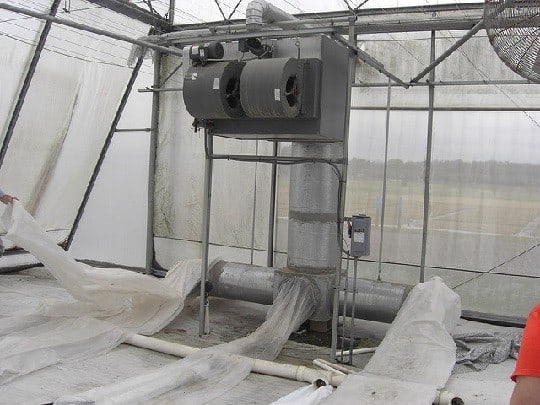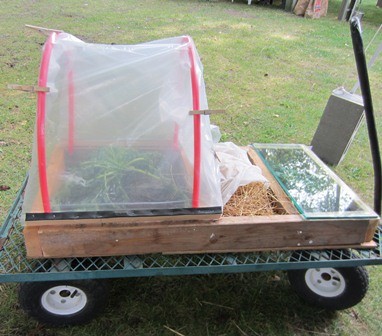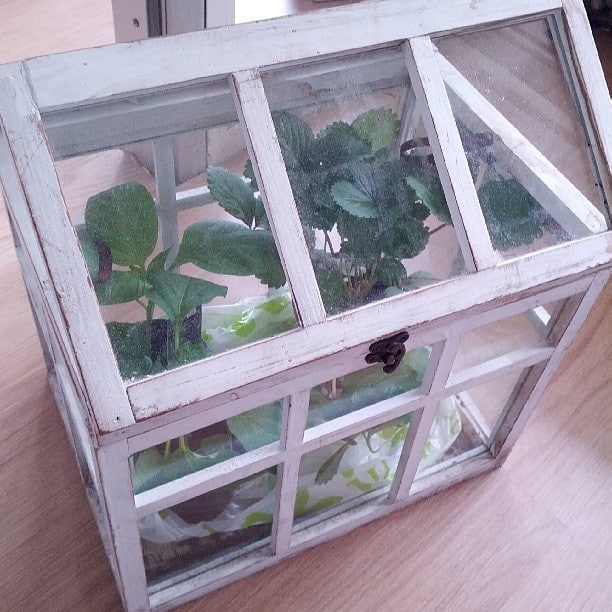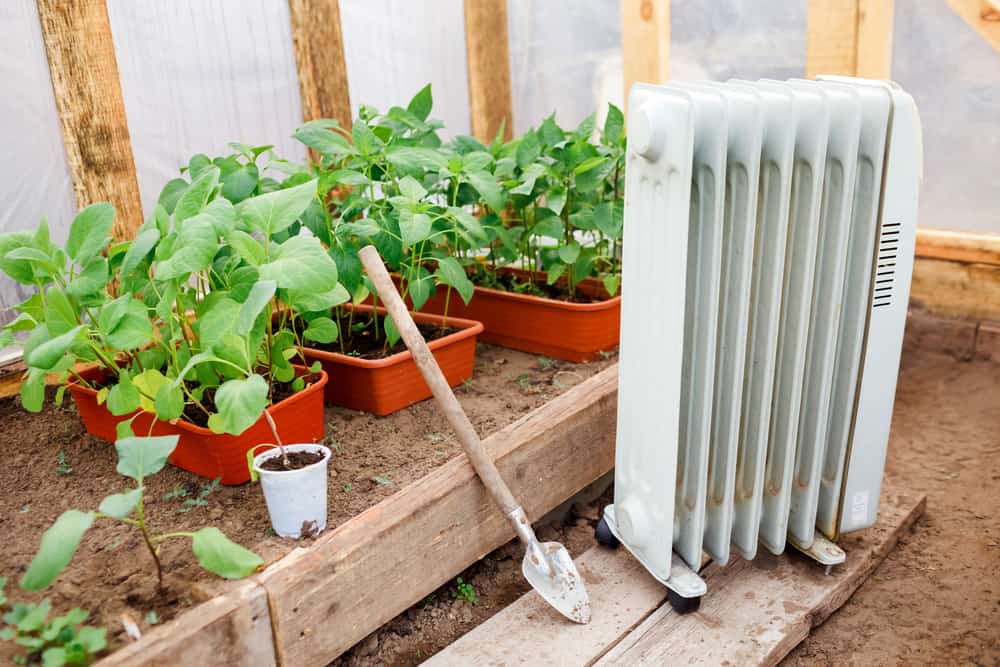A greenhouse heater can be a necessity for protecting vegetables and plants from cold weather. They help in maintaining sufficient temperature for vegetable and plant growth.
Investing in a good greenhouse heater is essential in ensuring that your vegetables or flowering plants are protected from frost during winter. It can help you optimize greenhouse gardening.
By minimizing the dampness or moisture in your greenhouse, they can accelerate the development of flowers and seedlings by encouraging optimal conditions.
Greenhouse heater and temperature control systems can also boost the air circulation inside the structure in summer.
You can have the best greenhouse lights for plant growth, but depending on your climate and what you want to grow, you may still need a heater for a greenhouse. It is a must if you live in a climate with cold seasons.
If you live in colder USDA hardiness zones 1a, 1b, 2a, 2b, 3a, and 3b, you may consider only gardening in the summer months. It may not be viable to grow certain plants all year, even with a heater.
Use this guide and greenhouse heater review to find one that meets your needs. You will also learn about the types of greenhouse heaters that are safe for different greenhouse structures.
Types of Greenhouse Heaters
What is the best heater for a small greenhouse? Greenhouse heaters can be powered by gas or electricity. There are different types of heaters. The choice of your greenhouse heater depends on your budget and the greenhouse structure and environment.
- Natural gas heaters
- Space heaters
- Forced-air heaters
- Hot water or steam heaters
- Electrical heaters
- Solar greenhouse Heater
- Soil heating cables
Gas-Based Greenhouse Heaters
Gas-based greenhouse heaters don’t need electricity. They can be used as individual heaters or in groups. This is the highest maintenance heater as it requires constant monitoring and adherence to strict safety measures.
It is less effective that an electric heater, but more affordable in the long run.
Space Heaters
You should buy a portable heater if you intend to move it around a lot in your greenhouse. Space heaters are considered a cheap choice for small greenhouse structures. They come in various sizes and are usually restricted to be used within a certain square feet of area.
They come in different types such as fuel-based, ceramic, infrared, portable or oil-filled.
Though these heaters are very handy, note the fact that the gas-based space heaters tend to emit noxious gases and hence, require a well-ventilated greenhouse.
Ceramic heaters never get hot on the exterior and hence, are safe to touch. They are also very energy efficient.
Forced-Air Greenhouse Heaters
A forced-air heater is considered by some to be the perfect small greenhouse heater. This uses a plastic or duct tube apparatus to distribute the heat inside a greenhouse.
Hot Water or Steam Greenhouse Heaters
A hot water or steam greenhouse heater operates with the addition of ventilation and using the principle of thermal mass, provides sufficient heating — no electricity or gas required.
Electric Greenhouse Heaters
An electric heater is efficient, clean, and easy to maintain and install. They are generally safe, very affordable and easily portable, enabling them to be used when required and stored during warmer months.
There are different sizes and styles of electric heaters at a wide range of prices, including tube heaters, radiant heaters, infrared and more.
However, the disadvantage of these heaters is that humid environments can cause issues with the electric heating source. You will have to check if they are designed to prevent shock.
Solar Greenhouse Heater
Greenhouse structures create a controlled environment for vegetables or plants by using the structure to trap solar radiation.
Solar heating helps to build an artificial environment within it which can sustain vegetables or plants when the natural temperature is low.
Colder environments need a solar greenhouse heater to retain proper temperature. Heat enters the structure through the covering of plastic or glass and starts to warm the environment inside the greenhouse with these heaters.
Soil Heating Cables
Another type of greenhouse heating method is by using soil heating cables. These cables look like an extension cord with an accompanying plug.
The cord is immersed into the soil, or installed inside the greenhouse structure benches and powered. They keep the surrounding temperature at a constant 75° to 80°.
right level for your space, you can easily do so by using the dual knob thermostat.

How to Choose the Right Heater for Greenhouse
Choosing the best from among a set of greenhouse heaters needs a lot of deliberate thinking and careful consideration.
Choosing a Greenhouse Heater
What type of crops or plants are you growing? Tropical varieties and crops grown for their fruit like tomatoes and oranges prefer temperatures of at least 60 degrees to 85 degrees. Anything hotter than 90 degrees will be harmful for them.
Winter crops prefer temperatures from forty five to seventy five degrees on the high end, with near perfect growth achieved at roughly sixty degrees.
To maintain the temperature, you’ll need a good temperature control system.
Structure of the Greenhouse
If your greenhouse is old, you will have greater chances of energy leaks from the walls, underground and the roof. Sturdy fiber glass, large sheets of glazing and many layers of heavy-duty plastic can help retain heat.
Location
Set up your greenhouse facing south and choosing a sunny location, free from any sort of shade, can go a long way in reducing your heating costs.
Area of the Greenhouse
Depending on your greenhouse area, you may need a few or many heaters to do the job.
Operating Cost to Run a Greenhouse Heater
Fuel like wood, kerosene and coal come at a cost. Yearly maintenance, battery and oil change have to be accounted for when you think of the heater cost.
Environmental Effects
Burning natural fuel can emit lots of noxious gases into the air, thereby polluting your plants. You can choose cleaner options like hydro, thermal or electric energy to counter this.
Greenhouse Temperature Control
Heating is an important matter for a farmer or gardener to take into consideration because a poorly designed system can have disastrous effects.
In most greenhouses, the temperature has to be balanced. So along with greenhouse heaters, you may have to install cooling elements too. It is important to understand how heating and cooling systems affect life inside a greenhouse:

Greenhouse Heating System Components
All these factors play a big role in deciding your entire heating system. The ideal temperature control system manages the climate by minimizing the adverse effects of both extremes.
Make your decision on purchasing the best greenhouse heaters and climate control greenhouse equipment by carefully considering these factors.
- Thermostat
- Ventilation
- Fans
- Windows
- Glass
Greenhouse Thermostat
A greenhouse thermostat is an instrument for regulating and controlling temperature of a system, so that you are assured that your vegetables or plants are in the right temperature.
They are a basic necessity for protecting flowers and plants from frost by holding a regular temperature for growth. They control the cooling and heating equipment to keep a constant set point.
Greenhouse thermostat instruments can alert you to any emergent temperature changes within your greenhouse with an alarm.
The capillary thermostat is one such thermostat that’s traditionally used by gardeners, as it is simple to install and use.
Electronic greenhouse thermostats are also quite popular these days. There are also digital thermometers that are very accurate and record barometric pressure and humidity levels, which is perfect for forecasting the cold season.
The humidity levels can show how dry it’s been inside the greenhouse and you can plan your watering schedule accordingly.
But they are costly. A regular mercury greenhouse thermometer reads well and is cheap enough for most gardens.
Another type of thermostat is the propagator or soil thermostat. These are used for monitoring greenhouse soil temperature.
Tips When Choosing a Thermostat for Your Greenhouse
One thing to keep in mind is that all greenhouse thermostats loose quality and purity over time. You’ll need to do a quality check on them once a year.
When installing a thermostat, choosing a right location is crucial. Make sure that the thermostat greenhouse can feel the temperature around the vegetables or plants.
Mounting the greenhouse thermostat on the greenhouse walls will not provide the good results. You ought to also ensure that the thermostat is not kept too close to direct sunlight or heating pipes.
When choosing a greenhouse thermostat, you can choose one with a variety of sensors. The thermostat device should automatically open and shut if the temperature falls below and rises above a certain degree.
When the temperature in greenhouse goes above the constant set point, the cooling instrument is activated and remains on until the temperature drops from set point. When the temperature drops below it, the thermostat activates the heating feature.
You can have a few greenhouse heaters or thermometers in different areas of your greenhouse to detect differences in various places within your greenhouse walls.
Small greenhouse temperature differences are known as micro-climates and they can affect plant growth, for the better or worse. Knowing where these greenhouse micro-climates are can enable you to grow apt varieties more wisely.
A greenhouse thermostat is a crucial piece of instrument and will keep plants and vegetables growing all year round along with greenhouse insulation.
Greenhouse Ventilation
Monitoring for greenhouse temperature extremes, both low and high, within the greenhouse structure is a requirement nearly every gardener struggles with. Optimum temperature varies for different plants.
Greenhouse temperatures for vegetables and plants where both root and leaf are desired, need slightly cool temperatures.
Greenhouse structures in hot climates often need cooling sources during the summer. During the warmer seasons, a greenhouse can roast plants. In dry climates, the greenhouse structure will to feel like an oven for the plants.
The aim of the greenhouse ventilation system is to keep a proper air flow from the front to the back of the structure. This creates air movement which in turn helps grow healthier plants.
Oftentimes, ventilation systems are a source of great confusion for inexperienced gardeners.
If you water your plants daily in a warm greenhouse, and still they do not produce results, then maybe its time you check your ventilation system.
Ventilating a Greenhouse with a Heater
Greenhouse ventilation systems are composed of various components. You must have intake shutters, ventilation fans, and sometimes even a thermostat.
The good way to install a greenhouse ventilation system is to put the exhaust fan on the back wall of the structure. The intake shutters ought to be down on the opposite greenhouse wall.
If you are using an exhaust fan with motorized intake shutters, you ought to have them wired to a greenhouse thermostat.
If you do this, you can set the greenhouse temperature at the exact point that you need and make the whole process automatic.
One of the greatest challenges of maintaining a greenhouse or nursery is the humidity control. Most flowers or vegetables enjoy a humidity of 50-60%, and it is difficult to manage it at times. Excess humidity can cause mildew, fungus and mold to grow on plants.
Hot dry weather and excess heat can cause your plants to dry out. A lack of air flow also causes fungi growth and diseases.
Therefore, ventilation is essential in the greenhouse to control temperature and humidity. Improperly constructed greenhouse vents can create excess heat and humidity.
A side and roof vent close to the floor can take out excess humidity. Sufficient ventilation also maintains the right balance of carbon dioxide and oxygen.
Certain types of vents open and close on their own. For others, you will have to manually adjust their flaps.
To keep pests out of the greenhouse, you can install a fine mesh screen over the vents. You can purchase greenhouse ventilation systems at an affordable price. Installing them is easy, as all they require are a few cuts in the structure.
Greenhouse Fans
Greenhouse fans are used to move the air inside your greenhouse. They spread heat, disperse humidity evenly and draw out hot, stale air.
They are valuable systems which minimize crop damage due to humidity changes and temperature. In extra humid climates, dry air is essential for blooming.
Greenhouse exhaust fans are used to create robust ventilation and reduce humidity in such places. These exhaust fans work on efferent axles that automatically open the fan covers according to conditions.
Other types of cooling systems used are evaporative greenhouse fans, water sprinklers or mist system, all of which can be used to boost or reduce moisture in the air.
These days, there are several types of fans which work on hanging stands, meters, mounts or timers. Choosing the right fan depends on the length, size, height and width of the greenhouse.
Some online sites offer an air circulator calculator.
Based on the structure you’re working with, these greenhouse fan calculators can tell you how many exhaust fans you need and how many intake vents are perfect for your greenhouse.
Greenhouse Windows
A greenhouse window is also called garden window. A garden window adds a three-dimensional interest to a wall with a pleasant vista of potted flowers and plants.
Windows in greenhouses have many advantages. For example, it can enable a more casual gardener to boost a selection of potted herbs, plants and flowers without the cost or space requirements of a larger size greenhouse structure. It also provides the ability for an individual to garden straight from the house.
Installing a window in your greenhouse is a great option for adjusting temperature fluctuations within its structure.
Although there are plenty of different styles, shapes and materials for greenhouse windows, most of them are either available in vinyl or aluminum. The appropriate choice will depend upon weather condition as well as the plants inside.
While vinyl greenhouse windows are more convenient, aluminum greenhouse windows attract far less sunlight. This may be a deciding element if you would like to boost the feel of the window.
There are a lot of advantages and disadvantages of both aluminum and vinyl greenhouse windows. Both will typically have side vents for more air circulation control. Vinyl windows usually have an aluminum frame for additional strength.
It means that the vinyl greenhouse windows are installed in the same manner as aluminum ones.

Tips for Greenhouse Window
When it comes to installing windows, you will have to measure your space to determine how much garden area is needed for it.
Depending on the smoothness of the greenhouse’s exterior, you may have to establish a small foundation where you want to fasten your window.
When you have fastened the new window to the greenhouse, you may have to establish supports to make sure that your greenhouse window does not break and fall.
While there are numerous types of flowers and plants that could be placed by a greenhouse window, it is best to narrow down your options and not crowd the window in case the greens block lights for other plants.
Greenhouse Glass
Greenhouse glass is just like any other piece of glass that is used on windows, but with a coating that prevents condensation on the surface.
Glass is the most important material in a greenhouse as it allows for sunlight to enter by trapping the radiant heat created inside. This makes it a passive solar collector.
The larger the pane of greenhouse glass, the more light it captures. A large pane will be expensive to replace and heavy in weight. Smaller panes are cheaper, but there will have to be more frame area, which will block light.
It will require a more durable frame, but will greatly improve the amount of light that comes into the greenhouse. Glass is not the best heat absorber in itself. So a heater might have to be used during nights in large window pane greenhouses.
A popular alternative to greenhouse glass is fiberglass. Fiberglass is much cheaper and lighter than glass, but has less light transmission features and yellows quickly.
It also cracks over time and needs regular replacement which negates the saved costs over glass. Fiberglass can look cheap as well.
Polycarbonate sheeting is similar to glass in light transmission and is better at retaining heat. It is less prone to breakage, but tends to deteriorates over time.
Best Greenhouse Heater Guide
Bearing in mind that the type of greenhouse heater used depends on the budget of the buyer and the environment in which it is going to be used. Let’s move on to some of the best greenhouse heaters available.
Best Greenhouse Heaters
- Dura Heat Propane Convection Heater
- Dr. Heater Greenhouse
- Bio Green PAL Palma Greenhouse Heater
- Comfort Zone Fan Forced Ceiling Mount Heater
Dura Heat Propane Convection Heater
First on the list is this greenhouse heater from Dura Heat. It houses a digital thermostat and ranges from -50°C to +99°C. It can be mounted on the wall where you plug the heater in. So it is referred to as a floor-standing heater.
It has a 15,000 – 25,000 BTU’s output accompanied by a 163m3/h air circulation rate which you can trust to distribute warm the air quickly while maintaining a consistent temperature in the greenhouse.
It comes in stainless steel that has adequate protection (IPX4 rated). This means it can withstand splashes from any direction, making it perfect for a damp room.
One feature that will get your attention is that it is pocket-friendly, as it saves you money on electricity bills. This is because it has low energy consumption. This is definitely one heater you want in your greenhouse.
Dr. Heater Greenhouse
This heater from Dr. Heater comes with a sweet feature which is an adjustable overheat thermostat. You can adjust the temperature to your required level.
It’s a single Phase 3000/6000W Commercial Electric Heater. It comes with a fan that is easily cleaned and emits no odor. In addition, it has a carry handle for easy mobility.
The heater isn’t the greatest, but it is cheap, powerful, and effective. If you’re searching for an average budget heater, this is the way to go.
Bio Green PAL Palma Greenhouse Heater
This heater is produced by Bio Green and offers an output of 1.5 kW” / 5.120 BTUs Greenhouse heater. It is perfect for greenhouses of up to 120 square feet. This heater is a fantastic addition to your greenhouse, with its timeless design, solid build quality, and stainless steel construction.
If needed, the Palma can also be used to maintain temperatures which are below 32°F, by using the optional digital thermostat.
Comfort Zone Fan Forced Ceiling Mount Heater
The last on our list is the CZ220 from Comfort Zone. It has a 5000W heating element capable of heating up to 60 square feet of a medium-sized greenhouse. It comes with piezo ignition, a regulator, a free hose and a safety valve all to make usage easier. This heater will help reduce moss growth.
If you need to adjust the temperature to just the right level for your space, you can easily do so by using the dual knob thermostat.
Heater for Greenhouse
Greenhouse heaters are one of the most important components in managing the temperature inside a greenhouse. It is essential that you buy heaters if living in a non-tropical area as they will avert any dangers of frost at night or with the change of seasons.
There are many types of greenhouse heaters available in the market such as forced-air, hot water or steam, space, natural gas and electric heaters.
Each have their own advantages and disadvantages with varying effects on the environment around them. Good quality plants can be grown only if the humidity and heat around them is controlled. For this, they need a climate control mechanism with proper ventilation.
It is important to move excess heat out of the greenhouse with fans and vents.
Sometimes, structural issues of a greenhouse can prevent it from holding proper temperatures.
A structural quality check along with a scientific assessment of the temperatures inside the greenhouse can help you grow good crops all year round.
Related content:

